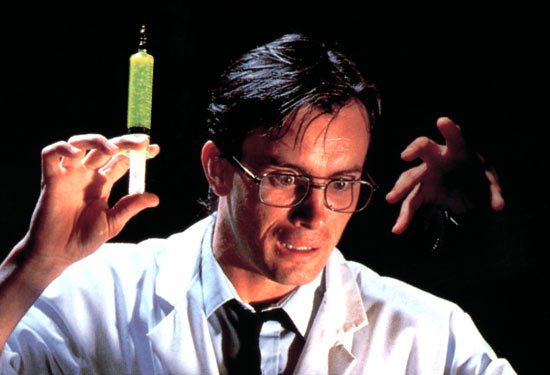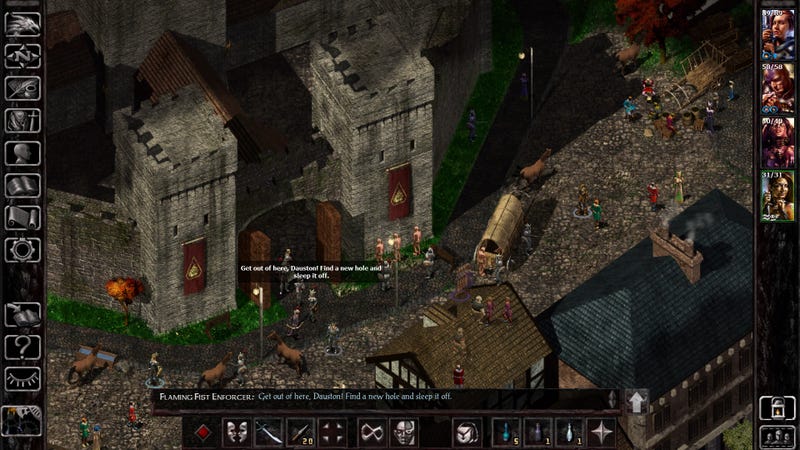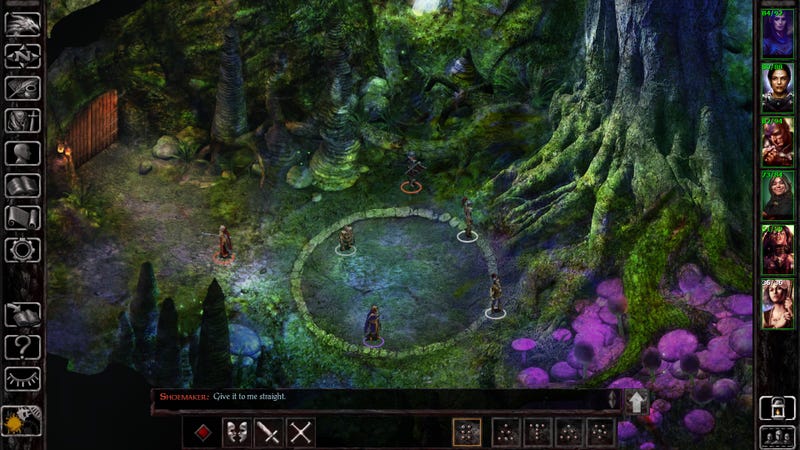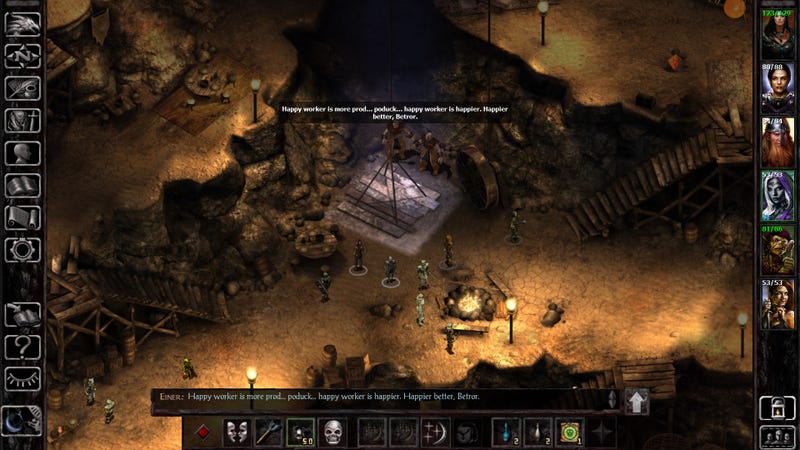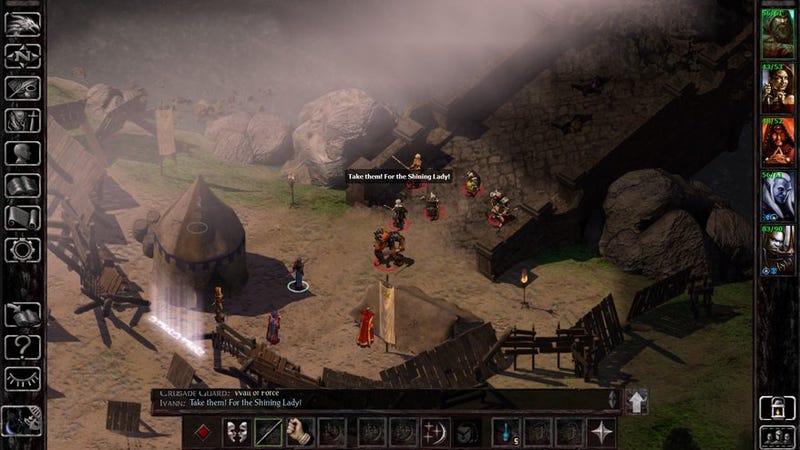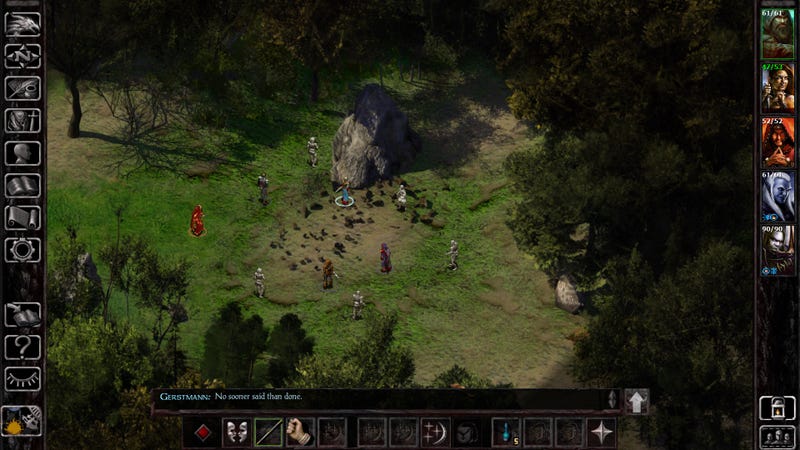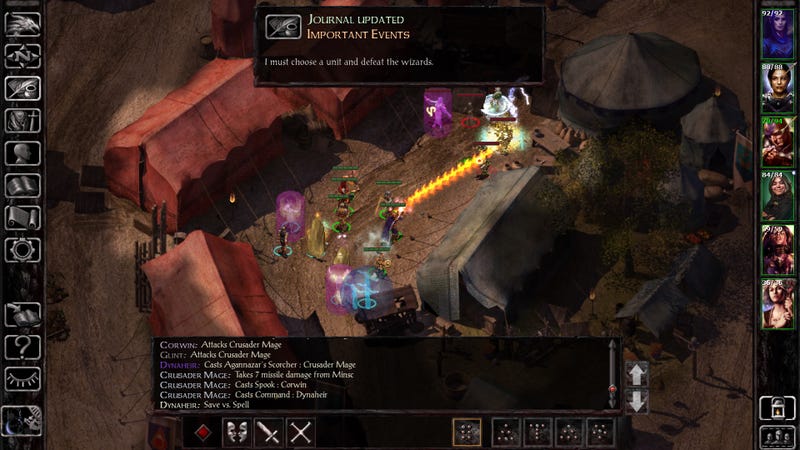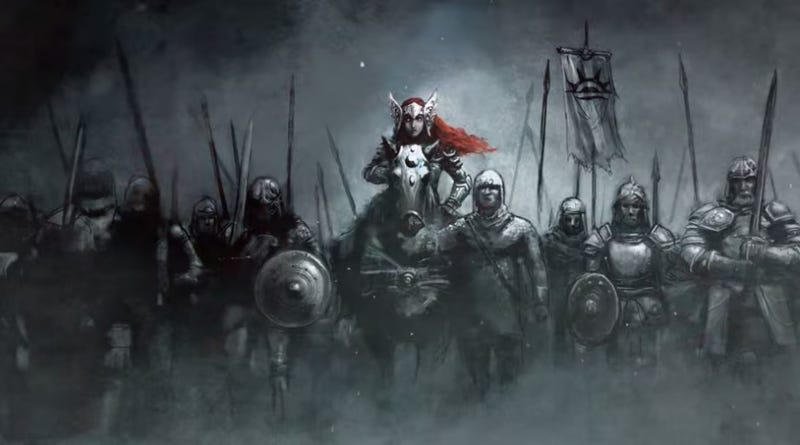The Struggle To Bring Back Baldur’s Gate After 17 Years
Baldur’s Gate is one of the most revered RPG series in video game history. It helped write the book on Western-style RPGs, putting a focus on memorable followers and party-based combat, and tossing it all in a blender with a dungeon and a dragon. Nearly two decades later, it’s back.
Beamdog is a small studio, but they have grand—verging on grandiose—plans. The company was founded by Trent Oster, BioWare co-founder, and Cameron Tofer, former BioWare lead programmer. They’ve been quietly tinkering away on Enhanced Editions of classic BioWare and Black Isle RPGs like
Baldur’s Gate,
Baldur’s Gate II, and
Icewind Dale, culminating in today’s release of
an all-new expansion, Baldur’s Gate: Siege of Dragonspear. Oh, and they also
recently brought on David Gaider, aka That Guy Who Made A Lot Of The Best Words In
Dragon Age And Other BioWare RPGs For 17 Years.
You might be sensing a trend here. Beamdog is made up of people who either lived the late-1990s RPG golden age or loved it, and they want to pick up where it left off. This is neither here nor there, but no, I don’t know what a Beamdog is either.
New Game Plus
The
Enhanced Editions? Those were phase one, a means of getting the ol’ Infinity Engine sea legs back. I’m not being (entirely) metaphorical when I use that terminology, either. You see, many of the assets used in the original
Baldur’s Gate games literally drowned.
“It was a big challenge because all of the
Baldur’s Gate original assets like the 3D models that make up these sprites, the 3D models for the levels in the original game, these archives were lost,” explained Beamdog lead designer Phillip Daigle during a recent interview at an event in San Francisco. “There was a data tape in some guy’s garage, and it flooded, and it was gone. There goes the history of
Baldur’s Gate. That’s the case with a lot of classic games. There was a single archive, it was in some guy’s basement and sorry, the disc rotted, and it’s gone now.”
The video game industry does a notoriously terrible job of preserving its history, so Beamdog had to start almost from scratch, reverse-engineering their own tools to remix and remaster games BioWare and Black Isle created many years ago. In some cases, it was a more... obtuse process than in others. Daigle showed me a crowded town square, a bustling city center writ large in dilapidated cobblestone. It looked nice, even by modern day graphical standards. Once upon a time, though, it was coffee.
“In the original
Baldur’s Gate,” explained Daigle, “these cobble stone streets here, this was just a close up picture of coffee beans and they just repeated over and over again. In ‘98 you had a 15 inch CRT, so you’re not going to notice or care probably. Nowadays when you’ve got an HD screen, you’re like, ‘Oh, those are coffee beans.’ We had to render out new streets and then lay them into the original 2D art and then paint over it. It was this whole process.”
He went on to tell me that Beamdog had to reverse-engineer basically everything: new character sprites, rigging, levels, camera angles/distance, and even fake camera lenses. “I think we’re about 90-95% new code at this point,” said Beamdog president Trent Oster. They also had to create a new style guide, a tome to reference when asking, “Is this thing we’re making in the spirit of
Baldur’s Gate?” It was all a very long, sometimes arduous learning process.
“The biggest thing we want to do is we wanted to build a company in our capabilities in a really smart way,” said Oster. “Do something where we can actually build the skills and abilities of our team in the right way. To me, the
Enhanced Editions [taught us how] to built content, to create content that fits.”
So that was phase one. Now, though, Beamdog is on phase two.
Dungeons and Dragons (and Spears)
Baldur’s Gate: Siege of Dragonspear is the first wholly original creation to come out of Beamdog. It’s an expansion to the first game in the series, meant to bridge a pretty large story gap between it and the sequel. At the end of the first
Baldur’s Gate, you’re a hero, having defeated your half-brother who had designs on becoming the next Lord of Murder (cool guy, a real hoot at parties).
At the start of the second game, you’re being tortured in a cave. Clearly,
something happened there.
Siege of Dragonspear explores that something while also giving more depth to the game’s world and characters and, of course, bringing back some old favorites for a farewell tour. It’s roughly 30 hours long, no small undertaking. “Throughout the development, we were constantly asking ourselves, ‘How can we make this more tied to the story? More tied to
Baldur’s Gate 1 & 2?’” said Daigle.
The goal was to make it all feel seamless, as though this expansion was dug up from a tomb of video game relics dating back all the way to the ancient 1990s. The writing style, the tone, the voice acting—everything had to be on point. That’s where spending years remaking the original games paid dividends. They even got people like Jennifer Hale and Jim Cummings to reprise roles they feared they’d forgotten.
“Everything that we added that was new, the question that was always, always on our mind was, ‘Does this feel like
Baldur’s Gate?’” said Daigle. “Does this enhance the
Baldur’s Gate experience or are we pushing it in a different and perhaps wrong direction? Half of our team is made up of ex-modders or guys who have been playing
Baldur’s Gate for 15 years. They know deep, deep in their bones what does and does not feel like
Baldur’s Gate. We leaned on them very heavily in terms of running designs past them. Does this feel like
Baldur’s Gate to you? Does this feel like you’re playing a
Baldur’s Gate adventure?”
Beamdog did, however, have
a little guidance from the past. They managed to unearth an old document of requests players made of BioWare after
Throne of Bhaal,
Baldur’s Gate II’s expansion, came out.
“At the very top of that list was, ‘I want to be able to take part in massive battles and command soldiers and do this huge thing,’” explained Daigle. “They couldn’t do it at the time, but we’ve made so many improvements and upgrades to the Infinity Engine that now we can have battles that have upwards of like a hundred combatants at once.”
Thus, the titular
Siege of Dragonspear, a scene from which Daigle walked me through. Sure enough, the battle was packed and chaotic, but, true to classic BioWare RPG form, informed by decisions Daigle had made earlier in the game. He’d made the choice to explore caverns beneath Dragonspear Castle, at which point he planted an explosive potion beneath the front gates. It certainly ended up coming in handy.
Beamdog’s devotion to the past is not, however, slavish in nature. While prized in gaming circles as though a holy grail or a landfill-fresh copy of
ET for the Atari 2600,
Baldur’s Gate is not a perfect game. After working for years to optimize the originals, Beamdog knew this all too well.
Siege of Dragonspear, then, is also significantly more modern than its grunge-listening, AOL-browsing fore-bearers.
Some of that comes down to interface and graphics. The UI is streamlined, character sprites have outlines for better visibility in combat, pausing mid-combat gives the environment a grayscale overlay, again making it easier to see what’s going on, and of course, the game looks and sounds nicer. But narrative and characters also got some touching up.
“If there was something for the original
Baldur’s Gate that just doesn’t mesh for modern day gamers like the sexism, [we tried to address that],” said writer Amber Scott. “In the original there’s a lot of jokes at women’s expense. Or if not a lot, there’s a couple, like Safana was just a sex object in BG 1, and Jaheira was the nagging wife and that was played for comedy. We were able to say, ‘No, that’s not really the kind of story we want to make.’ In
Siege of Dragonspear, Safana gets her own little storyline, she got a way better personality upgrade. If people don’t like that, then too bad.”
“I got to write a little tender, romance-y side quest for Khalid and Jaheira where you could learn a little bit about how their marriage works and how they really feel about each other.”
There’s also four new companions, one of whom is gay, one of whom is bisexual. There’s even a monster companion, a throwback to a
Baldur’s Gate II easter egg. But it’s not just about representation for representation’s sake. Beamdog wanted to give players options.
“We’ve got four new companions, and then there’s the returned Enhanced Edition companions and then a bunch of companions from
Baldur’s Gate 1,” said Daigle. “There’s a very wide and large roster in this game. You can build whatever kind of party you want. One of the problems in BG 1 and 2 was that it was kind of hard to have an evil party that worked. We put a lot of work into making it so can have an evil party that won’t screw you over, that will work in the game. You can be that evil character you want to be.”
The Next Generation
Phase one: remaster old games. Phase two: make new expansion for old games. You can probably guess what phase three is. If all goes according to plan, Beamdog wants to make their own game, and they sure hope it will be
Baldur’s Gate III.
“Basically,
Baldur’s Gate III, every two weeks when we call [
Dungeons & Dragons publisher] Wizards of the Coast, something comes up,” said Daigle. “The
Baldur’s Gate III thing, when are we going to do that? I think the answer is when the right people and the right partners line up, something big will happen.”
Beamdog president Trent Oster emphasized that doing the
Enhanced Editions and
Siege on Dragonspear has also been a means of cultivating a strong relationship with Wizards of the Coast.
Siege of Dragonspear, he said, was very much an ongoing collaboration, a back-and-forth conversation especially when it came to matters of lore and how to best leverage obscure portions of the D&D universe.
Despite all that, nothing’s set in stone. I asked Oster if Beamdog has considered the possibility of going their own way, making their own universe fantasy universe. He doesn’t want to leave the past behind, he told me. Not yet.
“There’s the idea of making all our own stuff, like BioWare did with
Dragon Age,” said Oster. “We created all of our own lore, created all of our things. It’s just, that’s a lot of hard, hard, hard work. If you don’t do the work right, when people play the game it comes off hollow. Even if you go crazy in your world building there’s kind of the opposite, it can hurt the experience.”
“In [Obsidian’s]
Pillars of Eternity, they told me about all these gods and these things that are going on, and I’m just getting hammered with lore,” he added. “I’m like, ‘Dude, I just want to get in and start learning about this world.’ Whereas D&D, I have all that knowledge and if I want some more knowledge I can just go on the internet or pop open a rule book. To me, that’s just the power that D&D has that crafting your own stuff from scratch just cannot have.”
But what about the ornery old Infinity Engine Beamdog’s been slowly gutting and replacing with newer, better guts? Surely there’s a temptation to build out a shiny new engine, ala the one the aforementioned
Pillars of Eternity used, right? Beamdog has mixed feelings on that front.
“The Infinity engine is old, there’s no doubt about it,” said Daigle, “but at the same time it has a certain flavor that other games don’t have. The D&D rule set here is so deep and interesting you and you can do some crazy things that you can’t just do with other games. It would be great if we had beautiful 3D characters on top of a rendered environment and all that, but we can accomplish all of that in the Infinity engine.”
“Our stance with the Infinity engine games is that if we ever move on from them into a more modern engine or something, we need to leave the Infinity engine in a state that is excellent so that people can enjoy it for another 20 years. If we leave it behind and you can enjoy this with your kids in 20-40 years then we’re extremely happy.”
So then, there it is:
Baldur’s Gate III with all textures made from different exotic coffee grounds, confirmed for 2036.

























